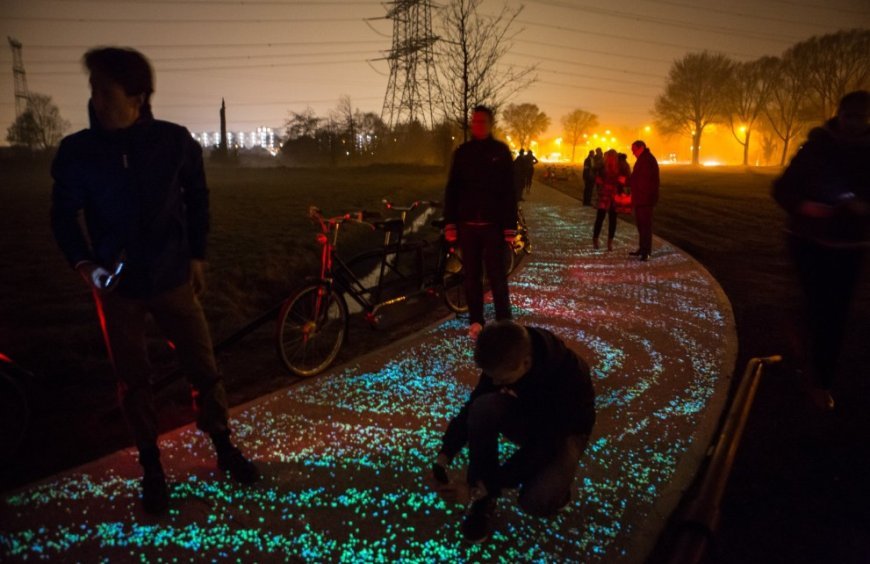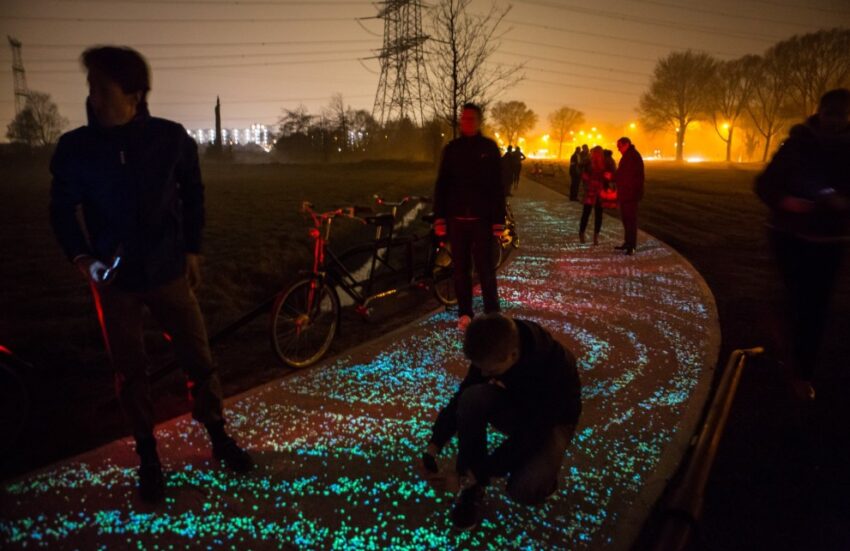Netherlands Unveils New Glowing Van Gogh Bike Path That Turns Night Rides Into a Starry Dream


In the quiet hours after sunset, a 600-meter stretch of cycle path between Eindhoven and Nuenen in the Netherlands transforms into something magical. The ground itself glows with thousands of softly lit swirls, echoing the brushstrokes of Vincent van Gogh’s Starry Night. Cyclists and pedestrians pass through patterns of light that seem to float under their wheels and feet, as if the painting has spilled from the canvas and settled on the earth.
This is the Van Gogh-Roosegaarde Cycle Path, an innovative public artwork that combines Dutch cycling culture with cutting-edge design. It was created to honor the life and legacy of one of the country’s most famous artists while also promoting sustainability and safety. Its distinctive glow is more than decoration — it’s a blend of art, renewable technology, and cultural storytelling.
The artistic spark behind the path
The project was conceived by Dutch artist and innovator Daan Roosegaarde, working with infrastructure company Heijmans. Roosegaarde is known for creating what he calls “techno-poetry,” a term he uses to describe work that fuses technology with art in a way that stirs emotion.
For this path, he drew direct inspiration from Van Gogh’s Starry Night, painted in 1889. The swirling motion of the stars and the deep blues of the night sky in that masterpiece became the visual foundation for the design. The location was also significant. The path runs between the Opwettense and Collse Watermills, both of which were captured in Van Gogh’s paintings during his time in the region.
The cycle path forms part of the larger Van Gogh cycle route in North Brabant, which connects sites associated with the artist’s life. This particular illuminated segment offers a vivid reminder of his work and the landscapes that inspired it.
Technology beneath the beauty
While the Van Gogh-Roosegaarde Cycle Path looks like a work of pure artistry, its operation is grounded in engineering and materials science. The path is embedded with thousands of small stones coated with a photoluminescent material. These stones absorb sunlight during the day, storing energy in the coating’s molecules. Once darkness falls, they release that stored energy as a soft glow, creating the swirling, starry effect.
On days when sunlight is weak, such as in winter or during cloudy weather, the design has a backup. Discreet solar panels power LED lights embedded along the path. These LEDs can supplement or replace the glow from the stones, ensuring the visual effect continues even without strong daylight.
The lighting is deliberately kept at a subtle level, avoiding glare while still providing enough illumination for safe nighttime cycling and walking. The design’s energy-saving approach means the path can operate without a constant power supply, reducing environmental impact.
Opening and cultural significance
The Van Gogh-Roosegaarde Cycle Path officially opened in November 2014, marking the 125th anniversary of Van Gogh’s death. The unveiling drew attention from both the art world and the sustainability sector. It was celebrated as an example of how cultural heritage can be honored through modern design and how public spaces can be enhanced with creative thinking.
By situating the path in an area tied to Van Gogh’s own life and work, the project creates a physical and emotional link between the past and present. Visitors are not just traveling through a functional cycle route — they are moving through an artistic space that connects them to one of the world’s most recognizable paintings and to the countryside that shaped its creator.
Cycling culture in the Netherlands
The choice to create an art installation along a bike path was no accident. Cycling is deeply embedded in Dutch life, both as a mode of transportation and as a leisure activity. The Netherlands is famous for its vast network of well-maintained cycle routes, which stretch across cities, towns, and rural landscapes.
By placing the installation in such a context, the designers ensured it would be experienced not as a static artwork but as something living and interactive. Every rider or walker becomes part of the moving scene, their motion echoing the flowing energy of Van Gogh’s painted night sky.
Visitor experience after dark
For visitors, the experience begins in daylight, when the path appears as a winding trail of pale stones. As evening falls, the transformation begins. The stones start to glow in shades of green and blue, arranged in swirling patterns that suggest the brushstrokes of Starry Night. The effect is both enchanting and calming, creating a dreamlike environment.
Cyclists often describe the feeling of gliding along the glowing surface as riding through a painting. For walkers, the slower pace allows time to take in the details, from the varying intensities of light to the way the patterns shift under different viewing angles.
The path is open year-round and free to access, making it a popular attraction for both locals and tourists. Many choose to combine a visit with other stops on the Van Gogh route, which includes museums, historical sites, and natural landmarks linked to the artist.
A model for sustainable design
Beyond its artistic value, the Van Gogh-Roosegaarde Cycle Path stands as a model of sustainable design in public infrastructure. The photoluminescent stones require no external power source to operate, relying instead on energy from the sun. The backup LEDs are powered by solar energy, avoiding dependence on the grid.
This approach reduces both energy consumption and light pollution. The gentle glow of the stones and LEDs provides enough illumination for safety without overwhelming the surrounding environment or disturbing wildlife. This is an important consideration in rural areas where bright artificial lighting can have ecological impacts.
The use of durable materials also contributes to sustainability. The stones and coatings are designed to withstand years of exposure to weather without significant fading or degradation. This longevity reduces the need for maintenance and replacement, further lowering the environmental footprint.
Public reaction and global attention
Since its opening, the Van Gogh-Roosegaarde Cycle Path has drawn praise for its creativity and innovation. It has been featured in international media, from design and architecture publications to travel blogs and news outlets.
Tourists often share images and videos of the glowing path online, helping to promote Eindhoven and the surrounding region as a destination for cultural tourism. The path has also been cited as an example for other cities seeking to integrate art and technology into functional public spaces.
Locals have embraced it not just as a tourist attraction but as part of their everyday environment. For regular cyclists commuting between Eindhoven and Nuenen, it turns an ordinary journey into a visually engaging experience.
Daan Roosegaarde’s broader vision
The cycle path is just one of many projects by Daan Roosegaarde that combine aesthetic appeal with practical purpose. His other works include the Smog Free Tower, an air-purifying structure that also produces jewelry from collected pollution particles, and Waterlicht, a large-scale light installation that simulates rising floodwaters to raise awareness about climate change.
Roosegaarde’s philosophy emphasizes the idea that public spaces should inspire as well as serve. By embedding beauty into everyday infrastructure, he aims to make the built environment more engaging and to encourage people to think differently about the relationship between technology, nature, and culture.
Blending tradition and innovation
The Van Gogh-Roosegaarde Cycle Path is a meeting point between tradition and innovation. It preserves and celebrates cultural heritage while employing advanced materials and renewable energy solutions. The glowing stones recall the artistry of the 19th century, while the technology behind them represents 21st-century progress.
This blend also reflects a broader trend in the Netherlands and beyond: the desire to create public infrastructure that is not only functional but also enriching. In a world where cities and regions compete for visitors and talent, such projects can become symbols of local identity and creativity.
Planning a visit
For those wishing to experience the path in person, the journey can begin in Eindhoven, a city known for its design culture and technological innovation. From there, it is a short ride or drive to the illuminated segment between Eindhoven and Nuenen.
The best time to visit is shortly after sunset, when the glow is most vibrant. On clear days, the fading natural light combines with the artificial stars underfoot to create a layered visual effect. In winter, the earlier sunset means the path comes alive during the late afternoon, making it accessible to more visitors before night falls fully.
The path is part of a larger cycling route, so bringing or renting a bicycle allows for exploration beyond the glowing section. Visitors can follow trails that pass through fields, villages, and sites linked to Van Gogh’s life, offering a mix of natural beauty and cultural history.
Why it matters beyond Eindhoven
While the Van Gogh-Roosegaarde Cycle Path is rooted in a specific location and cultural context, its concept has broader implications. It shows how infrastructure can be reimagined to serve multiple purposes — in this case, transportation, safety, cultural preservation, tourism, and sustainability.
Cities and regions around the world face the challenge of creating public spaces that meet practical needs while also enriching community life. Projects like this suggest that solutions need not be purely functional. By integrating art, technology, and ecological sensitivity, public works can inspire as well as serve.
The path also challenges assumptions about where art belongs. Rather than being confined to galleries or monuments, art can exist in the spaces people move through daily, turning commutes and errands into moments of unexpected beauty.
The lasting impression
For those who have experienced it, the Van Gogh-Roosegaarde Cycle Path leaves a lasting impression. It is both a tribute to an artist whose work has endured for more than a century and a testament to the power of design to transform the everyday. It captures the spirit of innovation that has shaped the Netherlands’ approach to infrastructure and public space.
In the glow of the stones and the swirls under the wheels of a bicycle, past and present meet. The path is a reminder that technology can enhance tradition, that sustainability can be beautiful, and that even a simple ride between two towns can become an unforgettable journey.
The post Netherlands Unveils New Glowing Van Gogh Bike Path That Turns Night Rides Into a Starry Dream appeared first on Travel And Tour World.






